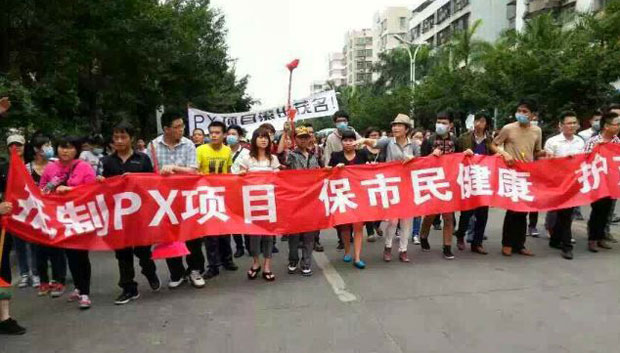On Sunday, locals in Maoming, Guangdong Province staged a protest against a proposed paraxylene (PX) plant in the city, and a subsequent police crackdown allegedly took lives and injured many. The Telegraph reports:
There are conflicting accounts of what happened next [after the demonstration began peacefully] but online photographs, which could not be verified and were in many cases deleted by censors, appeared to show a violent confrontation.
Images showed police kicking and swinging at protesters with batons and at least one burning police vehicle.
A number of bloodied protesters could be seen lying on the ground or being treated in what appeared to be a local hospital.
[…] Rumours that at least four teenagers were killed spread on social media but were denied by authorities.
As protests entered a third day on Tuesday, Sophie Richardson, China director at Human Rights Watch, called for an urgent and impartial inquiry into the police’s “apparent excessive use of force”. [Source]
Sophie Richardson, Human Rights Watch’s China director, has drawn attention to contradictions between the central government’s recent declaration of “war against pollution” and the use of force against those who engage in environmental protest. After the crackdown, smaller protests continued in Maoming for days. On Tuesday, demonstrations against the chemical plant and heavy-handed police response in Maoming were held in the provincial capital of Guangzhou.
An article from the state-run Global Times blames violence in Maoming on a minority of demonstrators, denies rumors of any deaths, and praises local police for their quick handling of the situation. The article continues to call for better communication with a public weary of the environmental impact of PX plants, and highlights the benefits that come with the domestic production of PX chemicals:
Aromatic hydrocarbon, which is produced by PX plants, is a basic material for the heavy chemical industry, but China has to depend on huge imports due to a domestic shortage of supply. Increasing the number of large-scale PX projects has vital bearing on China’s economy and people’s livelihoods. For a populous country, this high reliance on imports in the heavy chemical industry could pose long-term strategic risks. The majority of the Chinese public understands this.
[…] A lack of communication between local governments and the public plus poor official credibility constitute the roots of local repugnance against PX projects, further fueled by growing public upset over environmental pollution.
PX factories in Japan and South Korea are delighted to benefit from the soaring prices of hydrocarbon exports to China. The endorsement of local governments on the safety of PX programs is not trusted by the public. Instead, they only believe in an absolute safety brought about by derailing the plans. This must be stopped.
[…] We don’t believe all planned PX projects in China in recent years are unreasonable, ridden with environmental dangers. Therefore, a strong local government is needed so that it can withstand pressure, be capable and patient in negotiating with the public. Can Maoming act this way? We hope so. [Source]
Recent Chinese-language state media reports have likewise been emphasizing the need for domestic PX plants and the general safety of such projects [zh], while giving only sparse details on the alleged violence in Maoming. At the New York Times’ Sinosphere blog, Austin Ramzy looks at mounting public concern about PX production throughout China in recent years, and state media efforts to soothe anxiety:
In recent months some Chinese media outlets have urged protesters to not fear the expansion of paraxylene plants, saying the risks posed by the chemical don’t match the fears expressed in many Chinese cities.
[…] “Since the first PX plant was built in Shanghai in 1985, domestically at least 10 have been added,” the [People’s Daily] paper said [last year]. “At present they are all operating normally, with no major accidents.”
On the same morning the People’s Daily article was published, an explosion ripped through a PX plant in Zhangzhou, in Fujian Province, terrifying people who lived nearby but causing no injuries. The plant was the same facility that had been relocated from Xiamen after the 2007 protests.
In an editorial written after the Zhangzhou explosion, the Southern Metropolitan Daily said that residents’ lack of expertise, combined with the interest of local governments in pushing through projects despite safety concerns, contributed to widespread suspicion. It called for more transparency over future projects.
“Every time there is a protest, the panic over PX projects and mistrust in government expands,” it said. [Source]








